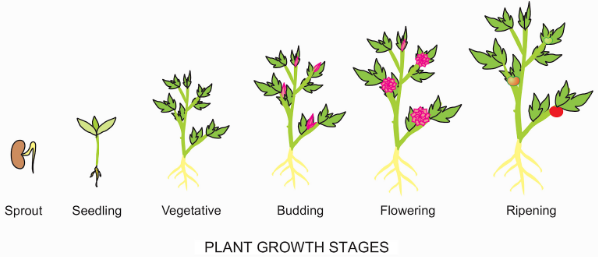
Identify the correct sequence of growth of plants.
(A) Number of fruits, number of leaves, and height of the plant
(B) Number of leaves, number of fruits, and height of the plant
(C) Number of leaves, the height of the plant, and the number of fruits
(D) None of the above
Answer
437.1k+ views
Hint: Plants have two phases in their life i.e vegetative phase and the second one is the reproductive phase. The reproductive phase comes after the vegetative phase and in this phase, plants produce fruits.
Complete answer:
Growth is the fundamental process of all living organisms present on Earth. There's a sequence of growth in all types of living organisms. In plants, the sequence of growth includes seed germination, then leaf formation, stem formation, leaf formation, increase within the height of plants, flower formation, and flower formation.
Phases of plant growth are as follows:
SPROUT:
Each seed of the plant contains a little number of nutrients, which is very necessary for the plants to germinate and start growing their first pair of leaves.
SEEDLING:
As plants start making their roots, and spread, a lift of quickly absorbed, well-balanced nutrients fuels the rapid climb from spindly seedling to healthy plant.
VEGETATIVE:
Nitrogen may be a key component of chlorophyll, the green pigment in plants, so it is the critical nutrient when their energy is concentrated on growing stalks and foliage.
BUDDING:
Phosphorus is in extra high demand at the beginning of a plant's reproductive cycle, the transition from growing leaves to form buds.
FLOWERING:
Potassium is known to play a primary role in producing and transporting the sugars and starches plants spend as they develop healthy flowers and fruit.
RIPENING:
When flowers and fruit of the plants are attaining full maturity, they have every week or two of just water without nutrients, a process referred to as "flushing," in order that they can spend all of the nutrients they need already absorbed.
So, the correct answer is ‘Number of leaves, the height of plant and number of fruits’.
Note:
Plants' lives could also be as short as a couple of weeks or months, but they are going through distinct changes as they grow even as people do. The nutritional needs of the plants change as they grow and increase in size.

Complete answer:
Growth is the fundamental process of all living organisms present on Earth. There's a sequence of growth in all types of living organisms. In plants, the sequence of growth includes seed germination, then leaf formation, stem formation, leaf formation, increase within the height of plants, flower formation, and flower formation.
Phases of plant growth are as follows:
SPROUT:
Each seed of the plant contains a little number of nutrients, which is very necessary for the plants to germinate and start growing their first pair of leaves.
SEEDLING:
As plants start making their roots, and spread, a lift of quickly absorbed, well-balanced nutrients fuels the rapid climb from spindly seedling to healthy plant.
VEGETATIVE:
Nitrogen may be a key component of chlorophyll, the green pigment in plants, so it is the critical nutrient when their energy is concentrated on growing stalks and foliage.
BUDDING:
Phosphorus is in extra high demand at the beginning of a plant's reproductive cycle, the transition from growing leaves to form buds.
FLOWERING:
Potassium is known to play a primary role in producing and transporting the sugars and starches plants spend as they develop healthy flowers and fruit.
RIPENING:
When flowers and fruit of the plants are attaining full maturity, they have every week or two of just water without nutrients, a process referred to as "flushing," in order that they can spend all of the nutrients they need already absorbed.
So, the correct answer is ‘Number of leaves, the height of plant and number of fruits’.
Note:
Plants' lives could also be as short as a couple of weeks or months, but they are going through distinct changes as they grow even as people do. The nutritional needs of the plants change as they grow and increase in size.

Recently Updated Pages
Master Class 11 Accountancy: Engaging Questions & Answers for Success

Glucose when reduced with HI and red Phosphorus gives class 11 chemistry CBSE

The highest possible oxidation states of Uranium and class 11 chemistry CBSE

Find the value of x if the mode of the following data class 11 maths CBSE

Which of the following can be used in the Friedel Crafts class 11 chemistry CBSE

A sphere of mass 40 kg is attracted by a second sphere class 11 physics CBSE

Trending doubts
10 examples of friction in our daily life

One Metric ton is equal to kg A 10000 B 1000 C 100 class 11 physics CBSE

Difference Between Prokaryotic Cells and Eukaryotic Cells

State and prove Bernoullis theorem class 11 physics CBSE

What organs are located on the left side of your body class 11 biology CBSE

Write down 5 differences between Ntype and Ptype s class 11 physics CBSE




